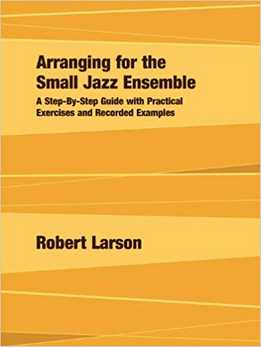Robert Larson — Arranging For The Small Jazz Ensemble — A Step-By-Step Guide With Practical Exercises And Recorded Examples
 Роберт Ларсон: «Аранжировка для маленького джазового ансамбля — пошаговое руководство с практическими упражнениями и записанными примерами».
Роберт Ларсон: «Аранжировка для маленького джазового ансамбля — пошаговое руководство с практическими упражнениями и записанными примерами».
Ноты, гармония, звуковые примеры. Текст распознан.
Содержание:
Preface
How to Use This Book
Use the Website
Before You Get Started
Example Tunes
Audio Recordings
Assignments
Free Staff Paper
Get Your Music Played
Part I
Form & Texture
Common Song Forms
A Closer Look At Song Forms
AABA Form
ABAC Form
The Twelve-Bar Blues
Chapter Summary
The Example Tunes
Swing Example Tune: “Why Not Now”
Analysis of “Why Not Now”
Latin Example Tune: “Sabrosa”
Analysis of «Sabrosa»
Ballad Example Piece: “December Serenade”
Analysis of “December Serenade”
Chapter Summary
Basic Arranging Structures
Instrumental Textures
Unison
Homophony
Polyphony
A Combination of the Above
A Further Simplification
Basic Arranging Structures
Chapter Summary
Part II
The Instruments of the Small Group
Brass and Saxophones
Writing For Wind Instruments
Memorize the Ranges
Range and Region Considerations
Instrument Combinations and Blend
Articulation Markings
The Trumpet
Trumpet Notation
Trumpet Range
The Registers of the Trumpet
Trumpet Mutes
The Trombone
Slide Positions and Technical Facility
Trombone Range
The Registers of the Trombone
Trombone Mutes
The Saxophone
Saxophone Transposition
Saxophone Ranges
The Registers of the Saxophone
Chapter Summary
The Rhythm Section
Role in the Ensemble
Notating Rhythm Section Parts
Comping
Rhythmic Notation
The Instruments of the Rhythm Section
Piano
Guitar
Bass
Drum Set
Drum Notation
Slash Notation
Background Figures
Rhythmic Notation
Reinforcement and Integration
Don’t Be Intimidated by the Rhythm Section!
Chapter Summary
Part III
Jazz Harmony & Voicings
Tertian Harmony
Close and Open Voicings
Four-Way Close Voicings
Chord Tone Substitutions
An Important Consideration: What Key Are You In?
Inversions and Positions
Jazz Chord Positions
The Value of the Piano for Arranging Students
Shell Voicings
Circle of Fifths Progressions
The ii–V–I Progression
ii–V–I Voice Leading
Minor Chord Progressions
Piano Exercises for the ii–V–I Progression
Choosing a Chord Position
Open Voicings
Drop-2
Drop-3 and Drop-2/4
Chapter Summary
Quartal Harmony
Quartal Harmony = Drop-2/4
Transposing Quartal Voicings
Quartal Voicings as Four-Note Structures
Quartal Voicings as Dominants
“So What” Voicings
Transposing “So What” Voicings
“So What” and Quartal Voicings in Context
Chapter Summary
Slash Chords
Uses of Slash Chords
Smoothing Out Bass Lines
Notating An Exact Sound
Simplifying Complex Structures
Chord Over Chord
Voicing Summary
Chapter Summary
Nonharmonic Tones
What is a Nonharmonic Tone in a Jazz Context?
Texture
Approach Techniques
Diatonic Approach
Diminished Seventh Approach
Dominant and Secondary Dominant Approach (with Preceding ii)
Parallel Approaches
Approach Techniques in Context
“Why Not Now”
“Sabrosa”
“December Serenade”
Chapter Summary
Part IV
Writing An Arrangement
Planning An Arrangement
Preliminary Steps: Listening and Analysis
Analyze the Tune
Listen to Recordings
Brainstorming
Annotate the Lead Sheet
Create A Schematic Diagram
Transferring Words Into Notation: Three Steps from Sketch to Finished Score
Step 1: Basic Sketch/Spontaneous Idea Stage
Step 2: Developmental Sketching
Step 3: The Finished Score
Chapter Summary
Two-Part Writing
Instrumentation
The Quartet: One Horn and Rhythm Section
The Quintet: Two Horns and Rhythm
The Sextet: Three Horns and Rhythm
The Septet: Four Horns and Rhythm
Two-Horn Writing
Writing a Countermelody
Characteristics of Specific Intervals in Harmony Parts
Thirds and Sixths
Parallel Fourths
Sevenths and Seconds
Example Tunes Harmonized in Two Voices
“Why Not Now” (Homophonic/Unison Texture)
“Why Not Now” (Combination Texture)
“Sabrosa” (Homophonic/Unison Texture)
“Sabrosa” (Combination Texture)
“December Serenade” (Homophonic/Unison Texture)
“December Serenade” (Combination Texture)
Conclusion
Chapter Summary
Four-Part Writing
Example Pieces Harmonized in Four Voices
“Why Not Now” (Homophonic/Unison Texture)
“Why Not Now” (Combination Texture)
“Sabrosa” (Homophonic/Unison Texture)
“Sabrosa” (Combination Texture)
“December Serenade” (Homophonic/Unison Texture)
“December Serenade” (Combination Texture)
Conclusion
Chapter Summary
Three-Part Writing
Three-Part Voicing Structures
Shell Voicings
Triads
Quartal Voicings and Clusters
Example Tunes Voiced in Three Parts
“Why Not Now”
“December Serenade”
Conclusion
Chapter Summary
Introductions
Common Introduction Types
Style Considerations
Improvised Introductions
Improvised Solo by a Horn, Piano, or Guitar
Drum Solo
Rubato Piano/Guitar Solo
Last Section of Melody
Vamp
I–bII7 Vamp
ii–V Vamp
Melodic Fragment
Unrelated Material
Harmony/Rhythm
Harmony/Rhythm + New Melody
Conclusion
Chapter Summary
Endings
Stock Endings
Common Ending Types
Style Considerations
Tags
Vamp
Melodic Fragment
Unrelated Material: Vamp
Unrelated Material: Newly Composed Section
Chapter Summary
Common Problems & Solutions
Parallel Harmonies
Parallel Thirds
Problem: Unstable Harmonization
Solution: Try Unison Instead
Parallel Fourths
Problem: Harmony In Fourths Too Strident
Solution: Try Unison or Guide Tone Harmony Instead
Awkward Lines
Problem: Awkward Lines In The Pick-Up Measure
The Solution: Integrate the Alto Line with the Rhythm Section
Awkward Repeated Notes
The Problem: Repeated Notes
Solution: Unison Trumpet and Alto
Overwriting
Problem: Too Much Complexity
The Solution: Write “In The Holes” Of The Melody
Lack of Integration with the Rhythm Section
Problem: Horns Not In Sync With Rhythm Section
Solution: Sync Horns with Rhythm Section
The “Correct” Version
Chapter Summary
The Complete Arrangement
Creating the Score and Parts
Notation Suggestions
Layout Suggestions
“Why Not Now”
Score Layout
The Arrangement
Solo Backgrounds
Interlude
Soli
Interlude Within the Soli (Measures 97–104)
First A Section Within the Soli (Measures 105–112)
Second A Section Within the Soli (Measures 113–120)
Ending
Send-Off
“Sabrosa”
Score Layout
The Arrangement
Solo Backgrounds
Shout Chorus
“December Serenade”
Score Layout
The Arrangement
“Finding the Groove”
Score Layout
The Arrangement
Solo Backgrounds
Shout Chorus
Chapter Summary
Conclusion
Appendices
Exercise Tunes
ABAC Swing Exercise Tune
AABA Latin Exercise Tune
AABA Ballad Exercise Tune
Sample Part
Staff Paper
Plain Staff Paper for General Use
Three-staff Sketch Paper (portrait orientation)
Three-staff Sketch Paper (landscape orientation)
Score Paper for Two Horns and Rhythm
Score Paper for Three Horns and Rhythm
Score Paper for Four Horns and Rhythm
EPUB + mp3. Вес файла 199 mb, zip архив. На английском языке. 2010 г.